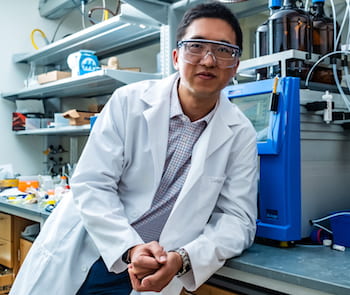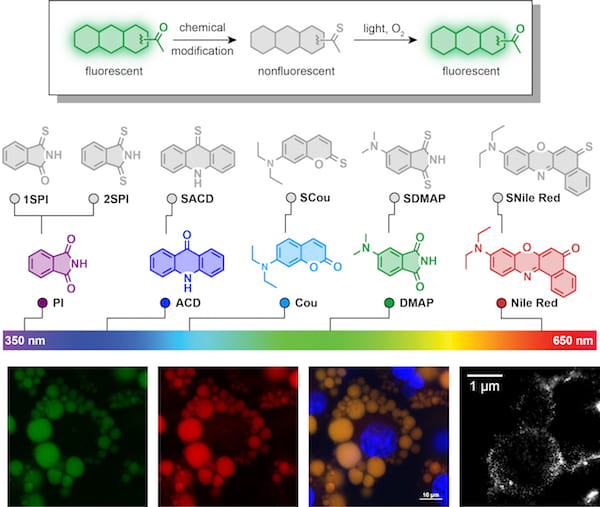Rice lab discovers simple technique to make biocompatible ‘turn-on’ dyes
It only took the replacement of one atom for Rice University scientists to give new powers to biocompatible fluorescent molecules.
The Rice lab of chemist Han Xiao reported in the Journal of the American Chemical Society it has developed a single-atom switch to turn fluorescent dyes used in biological imaging on and off at will. The technique will enable high-resolution imaging and dynamic tracking of biological processes in living cells, tissues and animals.
The Rice lab developed a minimally modified probe that can be triggered by a broad range of visible light. The patented process could replace existing photoactivatable fluorophores that may only be activated with ultraviolet light or require toxic chemicals to turn on the fluorescence, characteristics that limit their usefulness.
The researchers took advantage of a phenomenon known as photo-induced electron transfer (PET), which was already known to quench fluorescent signals.

Rice University chemist Han Xiao and his colleagues have discovered a simple method to turn fluorescent tags on and off with visible light by switching one atom. Photo by Jeff Fitlow
They put fluorophores in cages of thiocarbonyl, the moeity responsible for quenching. With one-step organic synthesis, they replaced an oxygen atom in the cage with one of sulfur. That enabled them to induce the PET effect to quench fluorescence.
Triggering the complex again with visible light near the fluorescent molecule’s preferred absorbance oxidized the cage in turn. That knocked out the sulfur and replaced it with an oxygen atom, restoring fluorescence.
“All it takes to make these is a little chemistry and one step,” said Xiao, who joined Rice in 2017 with funding from the Cancer Prevention and Research Institute of Texas (CPRIT). “We demonstrated in the paper that it works the same for a range of fluorescent dyes. Basically, one reaction solves a lot of problems.”
Researchers worldwide use fluorescent molecules to tag and track cells or elements within cells. Activating the tags with low-powered visible light rather than ultraviolet is much less damaging to the cells being studied, Xiao said, and makes the long exposures of living cells required by super-resolution imaging possible. Super-resolution experiments by Theodore Wensel, the Robert A. Welch Chair in Chemistry at Baylor College of Medicine, and his team confirmed their abilities, he said.
“We feel this will be a really good probe for living-cell imaging,” Xiao said. “People also use photoactivatable dye to track the dynamics of proteins, to see where and how far and how fast they travel. Our work was to provide a simple, general way to generate this dye.”

At top, a sequence shows the design of thio-caged dyes designed at Rice University to be triggered by visible light. At bottom, confocal and super-resolution imaging of a lipid droplet in living adipocytes incubated with BODIPY (green), SNile Red (red) and Hoechst 33342 (blue), followed by photoactivation using a 561-nanometer laser. Scale bar: 10 µm. Scale bar for super-resolution image of lipid droplet labeled with SNile Red, bottom right: 1 µm. Courtesy of the Xiao Lab
The researchers found their technique worked on a wide range of common fluorescent tags and could even be mixed for multicolor imaging of targeted molecules in a single cell.
Rice postdoctoral researcher Juan Tang is lead author of the paper. Co-authors are Rice graduate students Kuan-Lin Wu and Jingqi Pei; postdoctoral fellow Michael Robichaux of Baylor; and graduate student Nhung Nguyen and Yubin Zhou, an assistant professor at the Center for Translational Cancer Research at Texas A&M University. Xiao is the Norman Hackerman-Welch Young Investigator and an assistant professor of chemistry, biosciences, and bioengineering.
CPRIT, the Robert A. Welch Foundation, a Hamill Innovation Award, a John S. Dunn Foundation Collaborative Research Award and the National Institutes of Health supported the research.

